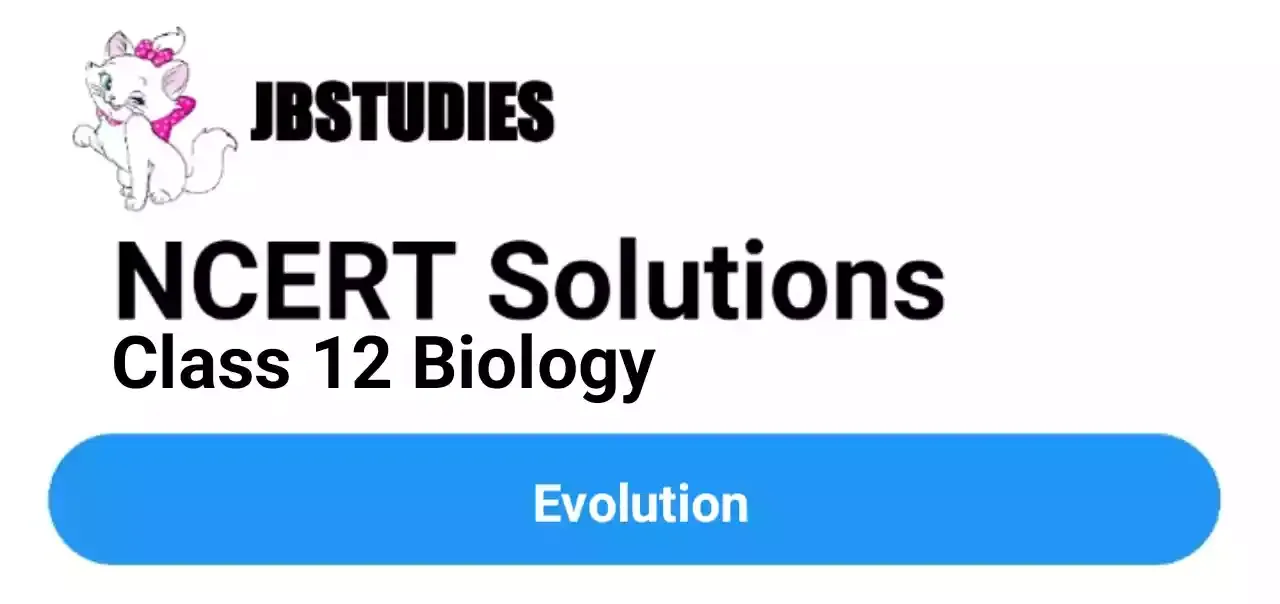NCERT Solutions Class 12 Biology Chapter-7 (Evolution)
We have given the answers of all the questions of NCERT Board Biology Textbook in very easy language, which will be very easy for the students to understand and remember so that you can pass with good marks in your examination.
Class 12 Biology
Chapter-7 (Evolution)
Questions and answers given in practice
Chapter-7 (Evolution)
Q1. Explain antibiotic, resistance observed in bacteria in light of Darwinian selection theory.
Ans: According to Darwin, environment selects organisms with favourable variations and these organisms are allowed to survive. When a bacterial population encounters a particular antibiotic, those sensitive to it die. But some bacteria having mutations become resistant to the antibiotic. Such resistant bacteria survive and multiply quickly as the competing bacteria have died. Some the resistance providing genes become widespread and entire bacterial population becomes resistant.
Q2. Find out from newspapers and popular science articles any new fossil discoveries or controversies about evolution
Ans: New fossil discoveries are as follows :
1. An international research team has recently discovered some amber fly specimens in El Sopalo cave (Cantabria, Spain). According to an article published in the scientific journal ‘Current Biology’, these specimens fed on nector and pollinated gymnosperm plants 105 million years ago.
2. Research conducted in Japan has revealed a very unusual new species of octocoral from a shallow coral reef in Okinawa, Japan. This new species can be considered as “living fossil,” and is related in many ways to the unusual blue coral.
3. The 48 million year old fossil, recovered from the Bridger Formation in Wyoming, is the first description of a new species, named Babibasiliscusalxiby the author, and
may represent the earliest clear member of the lizard group, Corytophanidae.
4. Neanderthals became extinct about 40,000 years ago but contributed on average one to three percent to the genomes of present day Eurasians. Researchers have now analysed DNA from a 37,000 to 42,000 year old human mandible in Romania and have found that six to nine percent of this person’s genome came from Neanderthals, more than any other human sequenced till date. Because large segments of this individual’s chromosomes are of Neanderthal origin, a Neanderthal was among his ancestors as recently as four to six generations back in his family tree. This shows that some of the first modern humans that came to Europe mixed with the local Neanderthals.
Q3. Attempt giving a clear definition of the term species.
Ans: Species is population or group of individuals that have potential of interbreeding and are able to produce viable, fertile young ones but are reproductively isolated from members of other species.
Q4. Try to trace the various components of human evolution (hint: brain size and function, skeletal structure, dietary preference, etc.)
Ans:%20(2).png)
Dietary preference:
Dryopithecus and Ramapithecus — herbivores Australopithecus Africans, Homo Carnivores habilis
Homo erectus, Homo sapinens — Omnivores
Q5. Find out through internet and popular science articles whether animals other than man has self-consciousness.
Ans: Recent studies on self consciousness says gibbons are the nearest to human in this respect. Apes and orangutans came next. Among domestic animals, dog and other members of canidae family show subtle self consciousness.
Q6.List 10 modern-day animals and using the” internet resources link it to a corresponding ancient fossil. Name both.
Ans: (i) Cockroach, Limulus (king crab), Neopilina, Latimaria (Fish) are fossil that has remain unchanged over years.
(ii) ‘Trilobites- fossil arthropods
(iii) Lung fishes – connecting link between fishes and amphibians
(iv) Peripatus – connecting link between annelids and arthropods .
(v) Woody mammoth – ice fossils
(vi) Gastropods – mould and cast fossil
(vii) Giant elk – amber fossil of asphalt
(viii) Dinosaur footprint – imprints
Q7. Practise drawing various animals and plants.
Ans: (1) Elephant%20(1).jpg)
(2) Camel%20(2).jpg)
(3) Dog%20(3).jpg)
(4) Rose%20(4).jpg)
(5) Dahlia%20(5).jpg)
(6) hibiscus%20(6).jpg)
Q8.Describe one example of adaptive radiation.
Ans: Darwin’s finches of the Galapagos islands had common ancestors but now have different types of modified beaks according to their food habits.
Q9. Can we call human evolution as adaptive radiation?
Ans: Yes, human evolution is an example of adaptive radiation as different species of human evolved across different areas of world as they diverged to different areas in following fashion.
(i) Hominid introduction occured in Africa and Asia:
(ii) Homo habilis lived in Africa – 2 million years ago.
(iii) Homo erectus- migrated to Asia and Europe and diverged into 2 species – Java Man and Peking Man.
(iv) Similarly Homo erectus – was followed by Homo sapiens.
(v) Primitive neanderthal man in Europe gave way to African cromagnon.%20(1).png)
Q10. Using various resources such as your school library or the internet and discussions with your teacher, trace the evolutionary stages of any one animal say horse.
Ans: Evolutionary stages of horse:
Eohippus – Mesohippus – Merychippus – Pliohippus – Equus.
Evolutionary trend:
(i) Increase in body size.
(ii) Elongation of neck.
(iii) Lengthening of limbs.
(iv) Enlargement of third digit.
(v) Increase in structural complexity of teeth for feeding on grass.
NCERT Solutions for Class 12 Biology PDF
- Chapter 1 Reproduction in Organisms
- Chapter 2 Sexual Reproduction in Flowering Plants
- Chapter 3 Human Reproduction
- Chapter 4 Reproductive Health
- Chapter 5 Principles of Inheritance and Variation
- Chapter 6 Molecular Basis of Inheritance
- Chapter 8 Human Health and Disease
- Chapter 9 Strategies for Enhancement in Food Production
- Chapter 10 Microbes in Human Welfare
- Chapter 11 Biotechnology:Principles And Processes
- Chapter 12 Biotechnology and its Applications
- Chapter 13 Organisms and Populations
- Chapter 14 Ecosystem
- Chapter 15 Biodiversity and Conservation
- Chapter 16 Environmental Issues




